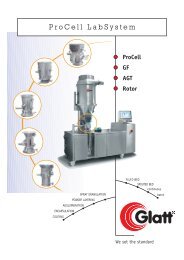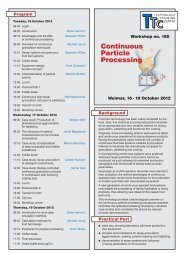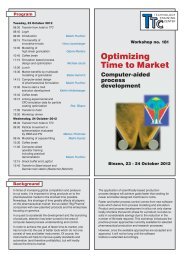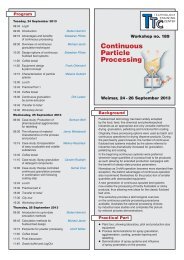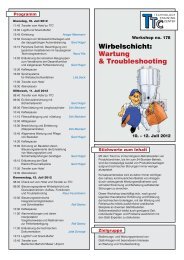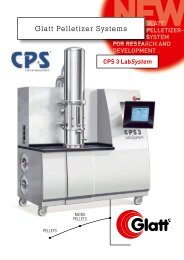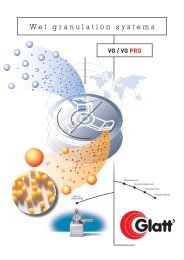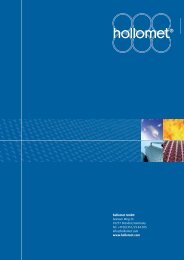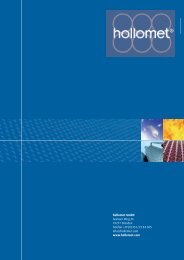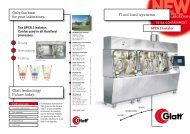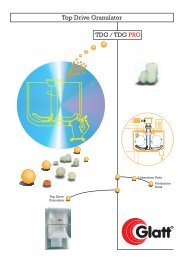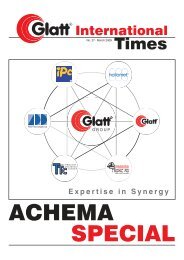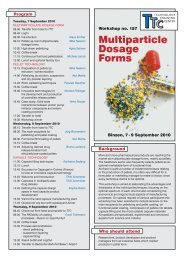PDF file - Glatt
PDF file - Glatt
PDF file - Glatt
Create successful ePaper yourself
Turn your PDF publications into a flip-book with our unique Google optimized e-Paper software.
Times<br />
No. 33 · January 2013<br />
SPECIAL<br />
Pharmaceutical<br />
Services
<strong>Glatt</strong> Pharmaceutical Services –<br />
advanced solutions for solid dosage forms<br />
1. <strong>Glatt</strong> – a brand for integrated process solutions for solid<br />
dosage forms<br />
When it comes to fluidized bed technology, <strong>Glatt</strong> has assumed a<br />
pioneer role and is the worldwide leader in integrated process solutions.<br />
<strong>Glatt</strong> offers a unique expertise and product spectrum and<br />
a comprehensive support service for pharmaceutical and related<br />
powder-processing industries. The support service starts with the<br />
product development for solid dosage forms and extends to the<br />
required process technologies, optionally even covers the planning<br />
and installation of the plant required for said technologies.<br />
<strong>Glatt</strong> is split up into four areas of expertise:<br />
• Process Technology Pharma<br />
• Pharmaceutical Services<br />
• Process Technology Food, Feed & Fine Chemicals<br />
• Process & Plant Engineering.<br />
Process Technology Pharma is the original and top-selling area<br />
of expertise of the <strong>Glatt</strong> brand. It includes the core business of fluidized<br />
bed systems for which <strong>Glatt</strong> has assumed a pioneering role<br />
and is considered a worldwide leading supplier.<br />
Technologies<br />
Services<br />
Pharmaceutical Services develops and produces solid pharmaceutical<br />
dosage forms. The core areas here are multiparticulates<br />
such as pellets and micropellets as well as granulates and the<br />
dosage forms resulting from them.<br />
Process Technology Food, Feed & Fine Chemicals develops,<br />
plans and distributes fluidized and spouted bed systems for the<br />
food, feed and chemical industries.<br />
Process & Plant Engineering plans, installs and realizes projects<br />
in plant construction worldwide. Its spectrum of expertise ranges<br />
from the expansion or reorganization of existing production<br />
plants to the construction of new ones – in part or as a whole.<br />
The company, which was founded by Werner <strong>Glatt</strong> in 1954, is<br />
made up of 14 branches and subsidiaries worldwide. In 2011, it<br />
employed 1,400 people and achieved total revenue in the hundreds<br />
of millions (in euros).<br />
2. <strong>Glatt</strong> Pharmaceutical Services’ area of expertise – who we<br />
are and where we come from<br />
From an organizational standpoint, Pharmaceutical Services<br />
represents the business unit within the <strong>Glatt</strong> Group which focuses<br />
on the development and production of solid dosage forms. One<br />
specific area of expertise is multiparticulate forms such as pellets<br />
and micropellets and the dosage forms that result from them. We<br />
make our experience and know-how of more than 50 years available<br />
as a service to our customers.<br />
Published by:<br />
79589 Binzen, Germany<br />
Formulations<br />
List of contents<br />
page<br />
<strong>Glatt</strong> Pharmaceutical Services –<br />
advanced solutions for solid dosage forms 2<br />
Thoughts on modern qualification 9<br />
CPhI Madrid 10<br />
TTC 184: Fluid bed processing 11<br />
TTC Program 2013 12<br />
Phone: + 49 (0) 76 21 / 664 535<br />
Fax: + 49 (0) 76 21 / 664 798<br />
E-mail: bianca.nowak@glatt.com<br />
Website: www.glatt.com<br />
<strong>Glatt</strong> Pharmaceutical Services Europe:<br />
A look into the Technology Center in Binzen, Germany<br />
<strong>Glatt</strong> has always made it possible for interested customers to test<br />
the <strong>Glatt</strong> technologies on a practical level. Product quality and<br />
process safety are requirements that need to be proven. They can’t<br />
just be developed and described theoretically at the drawing<br />
table, much less promised or guaranteed. Rather, they must prove<br />
themselves under hands-on conditions. This is why hundreds of<br />
pharmaceutical companies from all over the world have conducted<br />
experimental tests with their formulations at <strong>Glatt</strong>’s facilities.<br />
During these tests, they examined whether or not <strong>Glatt</strong>’s<br />
technologies could be successfully utilized for the realization of<br />
their product ideas. Over the years, this has enabled <strong>Glatt</strong> to<br />
acquire extensive know-how for optimal operation and utilization<br />
of its process technologies. Furthermore, <strong>Glatt</strong> has gathered a<br />
great deal of knowledge regarding pharmaceutical formulations<br />
and technology platforms. We offer our customers this knowledge<br />
as a service for all the different phases of a product life cycle.<br />
2<br />
Times · No. 33 · January 2013
Experiments require a lab. The “pilot plant” at the headquarters in<br />
Binzen, which for several decades provided valuable services for<br />
the continued development of the company, was slowly going out<br />
of date in the 90s. In addition, the available equipment was no<br />
longer considered state of the art and the spatial conditions were<br />
not presentable to the pharmaceutical clientele any longer. So, in<br />
1994, <strong>Glatt</strong> decided to build a new pharmaceutical technology<br />
center in Binzen. <strong>Glatt</strong>’s plant construction department moved<br />
into new spaces so that the buildings and areas they formerly utilized<br />
were now always available to them. One vital question was:<br />
“Should we tear down everything and build it all from scratch or<br />
should we renovate parts of a historic building and integrate them<br />
into the new complex?” The answer turned out to be the latter,<br />
which appears to have been the right decision. After all, many visitors<br />
today enjoy coming across a modern communication center<br />
in a former barn: This is a place with flair and a special atmosphere,<br />
which a modern functional building is not really able to offer.<br />
3. What we stand for and what we offer<br />
<strong>Glatt</strong> started out as a simple manufacturer of process plants. Over<br />
the years, the concept “one source fits all” increasingly started to<br />
become the focus. Today, for example, <strong>Glatt</strong> customers can’t only<br />
purchase plants or systems; rather, they have a broad spectrum of<br />
services at their disposal in order to develop and produce pharmaceutical<br />
products. At the same time, our “one source fits all”<br />
approach differs greatly from how typical pharmaceutical contract<br />
manufacturers interpret it. These manufacturers oftentimes deal<br />
with a very broad spectrum of pharmaceutical dosage forms and<br />
offer commercial production of ready-to-use drugs including<br />
packaging.<br />
The <strong>Glatt</strong> area of expertise Pharmaceutical Services, however, interprets<br />
the expression “one source fits all” completely differently.<br />
We focus on a service spectrum for the area of solid dosage forms.<br />
Formulation Portfolio and Focus on Core Competences<br />
know-how<br />
experience<br />
technical capabilities<br />
pellet +<br />
micropellet<br />
products<br />
i.v., i.m.<br />
creams<br />
liquids<br />
lzo's<br />
granules<br />
coprecipitates<br />
adsorbates<br />
tablets<br />
mini<br />
tablets<br />
coated<br />
tablets<br />
matrix<br />
tablets<br />
ophthalmics<br />
oral films<br />
plasters<br />
aerosols<br />
<strong>Glatt</strong> Pharmaceutical Services in Binzen, Germany<br />
Where there had previously been an “old pilot plant,” a modern<br />
pharmaceutical technology center was now being built. In the beginning,<br />
however, it wasn’t quite clear yet how the new spaces<br />
would specifically be utilized later on. Some of the questions<br />
being asked were: “Will we be conducting only technical, non-<br />
GMP experiments?” or “Should we maybe also produce clinical trial<br />
material under GMP and just switch from the non-GMP status to<br />
the GMP status? Is that even possible?” In the end we decided to<br />
permanently run our technology center under GMP conditions.<br />
These conditions allow for, on the one hand, technical experiments<br />
to be conducted and, on the other hand, clinical trial material,<br />
registration batches and commercial bulk goods to be<br />
produced.<br />
All GMP-relevant systems and the number of employees started<br />
pretty much at zero. In 1998, the time had finally come: The Regional<br />
Commission Freiburg approved the new site and granted its<br />
pharmaceutical manufacturing permit. Lastly, in 2006, the approval<br />
from the US Food and Drug Administration (FDA) followed,<br />
which meant a considerable expansion of opportunities for us in<br />
the international environment. Today, we also have the permission<br />
to process controlled substances.<br />
This is how, over the years, a pilot plant grew into a complete business<br />
unit: <strong>Glatt</strong> Pharmaceutical Services.<br />
focused portfolio<br />
focused experience<br />
focused technical capabilities<br />
<strong>Glatt</strong> Pharmaceutical Services: pharmaceutical dosage forms portfolio<br />
Our core competence lies in the development, optimization and<br />
production of bulk products for clinical trials, registration and, in<br />
the case of selected products, for marketing. We closely combine<br />
our pharmaceutical services with the level of competence and the<br />
services of a worldwide leading pharmaceutical plant manufacturer.<br />
<strong>Glatt</strong> is therefore able to offer the entire service program, from<br />
the formulation development to the production technology and,<br />
optionally, even the ready-for-use plant. Pharmaceutical developers<br />
and manufacturers benefit from the know-how and the support<br />
of the plant construction team, and vice versa. Thus, to <strong>Glatt</strong>,<br />
“one source fits all” represents a concept of integrated process<br />
solutions that go beyond business unit boundaries, with a seamless<br />
support system for the customers.<br />
It’s been a while since <strong>Glatt</strong> has been involved only in the pharmaceutical<br />
sector. Increased demand for the refinement of products<br />
in other industry segments opened up new markets. Customers<br />
from the food, feed and fine chemical industries benefit from our<br />
experience as part of the pharmaceutical industry. On the other<br />
hand, pharmaceutical companies can revert back to technologies<br />
that were originally developed for different applications and markets.<br />
The synergies between our inter-divisional plant business<br />
and pharmaceutical services offer our customers a unique competence<br />
and service spectrum. By utilizing and offering innovative<br />
process technologies, we are making it possible for our customers<br />
to develop and produce cutting-edge pharmaceutical products.<br />
Times · No. 33 · January 2013<br />
3
We would like to enable our customers to produce excellent, innovative<br />
and user-friendly pharmaceutical products. In order to do<br />
so, we employ our expertise for formulation and process development.<br />
Our primary focus lies in the challenging cases that are in<br />
development and finding innovative approaches to deal with<br />
them. One of our core competences is the development and production<br />
of multiparticulates such as pellets and micropellets.<br />
Oftentimes, these systems involve a guided and controlled release<br />
of pharmaceutical substances or the taste masking of substances<br />
that taste bad. From these pellets and micropellets we then produce<br />
the desired application form such as capsules, tablets and<br />
mini tablets, oral disintegrating tablets (ODT), sachets, stick packs<br />
and oral liquids.<br />
Pellet and Micropellet products<br />
oral suspension sachets / stick pack ODT's<br />
< 500 µm<br />
MUPS<br />
< 800 µm<br />
fixed dose<br />
combinations<br />
Some of <strong>Glatt</strong> Pharmaceutical Services’ core competence drug products<br />
capsule<br />
We possess special technologies for processing drugs that are<br />
hardly soluble in water and therefore hard to absorb into suitable<br />
dosage forms. We also work with sustained release tablets of varying<br />
textures and consistencies.<br />
Even in the early development stages, we strive to achieve stable,<br />
reproducible and economical processes. We choose the most suitable<br />
formulation and production technology for each individual<br />
product from the broad <strong>Glatt</strong> technology spectrum. Here we also<br />
utilize our vast inter-divisional competence in order to find optimal<br />
solutions for our customers.<br />
We continuously receive tasks that are new to us as well and for<br />
whose solution we must now find suitable technologies. Particularly<br />
when new technologies need to be developed and used, we<br />
benefit greatly from our colleagues in the process technology area<br />
of expertise. In close collaboration with engineers, designers and<br />
control systems experts we develop and realize new technical<br />
solutions. Shorter paths and reaction times are possible because<br />
we all work at the same site. This enables us to find quick and<br />
comprehensive solutions for our customers. This special collaboration<br />
is only possible through the combination of experts in pharmaceutical<br />
pilot construction and pharmaceutical development<br />
and production. In other words: “One source fits all.”<br />
The <strong>Glatt</strong> technology centers in Binzen and Ramsey, New Jersey,<br />
USA are hubs for new ideas. This is where experts from various different<br />
disciplines and many countries of the earth come together.<br />
Practitioners converse with researchers and developers, customers<br />
chat with manufacturers.<br />
Our pharmacists who work in pharmaceutical development, production,<br />
quality control and quality assurance speak to our partners’<br />
pharmacists. Together we develop strategies and approaches<br />
for pharmaceutical development. We believe that speaking a common<br />
technical language is an important element for a successful<br />
collaboration.<br />
4. Our customers and their projects – and how we work<br />
Our customers not only come from various diverse parts of the<br />
world; they also come from different companies and company<br />
types. Yet each company should be looked at and treated as individually<br />
as the people who work there. Whether these are international<br />
global players or startups, originator or generic companies,<br />
OTC or animal health companies.<br />
Our specialized know-how can be used on a broad scale, such as<br />
for the development of life cycle management products and pediatric<br />
dosage forms for humans as well as for specific taste-masked<br />
dosage forms intended for animal health.<br />
We handle projects in the spirit of a fee-for-service concept. This<br />
means: We make available to our customers as a service our knowhow,<br />
our technologies and our technical possibilities and are compensated<br />
for doing so. The rights to the product that results from<br />
this and to the technology platforms are regulated individually as<br />
part of development contracts.<br />
We handle projects based on a flexible approach which involves<br />
making project plans available to our customers. The scope of<br />
work suggested by us and the resulting costs then emerge from<br />
these plans. We discuss the plans and milestones and together<br />
decide on the scope, the approach and timelines. The individual<br />
milestone packages can be accessed and ordered separately,<br />
which allows our partners to be very flexible. If necessary, you can<br />
continue or end your project at a sensible point in time.<br />
<strong>Glatt</strong> Pharmaceutical Services Service portfolio<br />
Preclinical Development<br />
Development<br />
of API<br />
Preclinical<br />
studies<br />
formulation development<br />
process development<br />
Phase I<br />
CTM supply phase I and II<br />
formulation + process optimisation<br />
Clinical Development<br />
scale-up to pilot scale<br />
CTM supply phase III<br />
registration batches<br />
scale up to commercial + validation<br />
launch / commercial supplies<br />
analytical characterisation / compatibility studies / stability studies<br />
Classical milestones of a pharmaceutical development<br />
Phase II Phase III Registration Market<br />
Launch<br />
Our project plans and cost structures are transparent, which is<br />
very important to us and helps maintain a trusting collaboration<br />
in the spirit of partnership. This way, we are able to demonstrate at<br />
any given time which part of the agreed-upon work we have completed<br />
and which part of the developmental budget we have<br />
already exhausted. We work in a goal and result-oriented manner<br />
and find it to be insufficient and not very goal-oriented to simply<br />
“work off” a work package that was outlined once, which is why<br />
we point out to our partners when we believe goal adjustments<br />
are sensible and necessary. We then implement these adjustments<br />
together.<br />
Close to 60 people are employed at the German headquarters for<br />
<strong>Glatt</strong> Pharmaceutical Services in Binzen. Our slender organizational<br />
structure and the close spatial proximity of everyone involved<br />
create many advantages: They allow for us to work together closely,<br />
to communicate on a personal level with each other and to<br />
4 Times · No. 33 · January 2013
make speedy decisions. We are convinced that the way in which<br />
we work on projects can optimize our customers’ “time to market.”<br />
We are also convinced that an effective speed during the project<br />
development stage has to be based on a distinct quality standard.<br />
For us specifically this means: Speed through quality.<br />
We enjoy working with our partners on a long-term basis. Nevertheless,<br />
from the start of the project, our customers are free to<br />
choose their partners. Selected bulk products are produced in our<br />
pharmaceutical production, either on a permanent basis or until<br />
our partner invests in his or her own production technology.<br />
During this process, we lend a hand in the product transfer to<br />
other production facilities and help with the implementation and<br />
validation of the processes.<br />
5. Our technology platforms and know-how<br />
We systematically apply our expertise and resources in selected<br />
formulation areas. Our field of activity covers solid dosage forms.<br />
Generally our customers approach us with demanding development<br />
cases.<br />
Intelligent and high-quality medicines require a corresponding<br />
process technology. Here, <strong>Glatt</strong> offers an ideal solution: On the<br />
one hand, process technologies can be delivered as plants and<br />
systems or, on the other hand, Pharmaceutical Services offers<br />
those services that enable an optimal utilization of the technologies<br />
for the customers. We know the process plants, systems and<br />
technology platforms we developed and built better than anyone<br />
else. Our profound understanding of technology allows us to utilize<br />
the plants and processes in an optimal way for our customers.<br />
Due to the fact that we are constantly further developing our<br />
technologies, we are also broadening the application spectrum<br />
and options for new pharmaceutical products.<br />
Product characteristic diagram<br />
500 µm<br />
CPS<br />
matrix<br />
pellets<br />
Batch<br />
process<br />
Micropellets<br />
possible<br />
MicroPx<br />
matrix<br />
pellets<br />
Continuous<br />
process<br />
Micropellets<br />
possible<br />
Wurster<br />
Process drug<br />
layered pellets<br />
Batch<br />
process<br />
Micropellets<br />
possible<br />
<strong>Glatt</strong> Technologies for different multiparticulate products<br />
Later on, people started using fluidized bed technology for applying<br />
drug substances and coating films starter particles. Today, the<br />
bottom spray or Wurster technology represents a worldwide<br />
established and leading process for the production of multiparticulates.<br />
The powder-layering technology allows for the coating of<br />
particles with powders. Furthermore, fluidized bed processes were<br />
developed that enable the production of pellets and micropellets<br />
without the use of starter pellets. Here, one can choose from batch<br />
and continuous processes. On the one hand, this enables the production<br />
of a variety of product qualities, but also the use of an<br />
optimal technology while taking into consideration economic<br />
factors.<br />
The development and production of pellets and, in particular, of<br />
micropellets with a size of 100 to 500 micrometers, requires a very<br />
specific technical know-how and a particular technology.<br />
Varying drug release kinetics can be achieved by using specific<br />
formulation approaches. A variety of options is realizable with pellets<br />
and micropellets, including the quick release of the agent to<br />
the delayed, modified or pulsatile release, from the enteric resistant<br />
to the taste-masking form.<br />
Immediate, sustained, zero order release<br />
Extruded<br />
matrix<br />
pellets<br />
Batch<br />
process<br />
Procell<br />
pellets<br />
Continuous<br />
process<br />
—— Micropellets<br />
possible<br />
<strong>Glatt</strong> MicroPx Technology<br />
Many years ago, fluidized bed<br />
technology made a splash in the<br />
pharmaceutical industry and became<br />
known as an innovative<br />
drying technology. Over time it<br />
turned into a fluidized bed granulation<br />
process, which, for<br />
example, enables the production<br />
of particularly porous granulate<br />
structures. These types of granulate<br />
qualities are particularly suitable<br />
for substances that are very<br />
difficult to dissolve in water. The<br />
porous structures, which are<br />
achieved by the fluidized bed<br />
granulation process, make it<br />
easier for the physiological liquids<br />
to penetrate the tablets<br />
and granulates and to quickly<br />
dissolve them.<br />
Drug release<br />
Delayed, pulsatile release<br />
Drug release<br />
Time<br />
Time<br />
Drug release pro<strong>file</strong>s achievable with <strong>Glatt</strong> formulation and process technologies<br />
Modified release dosage forms allow the patient a more comfortable<br />
intake of a medication as it has to be taken less frequently, no<br />
more than once or twice daily. Even the number of side effects<br />
that may occur due to plasma peaks of the active, can be reduced<br />
through optimized drug releases and plasma levels.<br />
Times · No. 33 · January 2013<br />
5
When high-dose pharmaceutical medicines are to be processed<br />
into micropellets with the greatest possible active substance ratio,<br />
it can be quite difficult to find a suitable process. Traditional pelletization<br />
processes such as extrusion, for example, are not suitable<br />
for these kinds of small particles.<br />
Selected <strong>Glatt</strong> technologies for multiparticulates processing (from left to right):<br />
<strong>Glatt</strong> Wurster (bottom spray) Technology, <strong>Glatt</strong> CPS Technology, <strong>Glatt</strong> MicroPx<br />
Technology<br />
The classic Wurster fluidized bed technology can be applied when<br />
low-dose medicines are to be formulated into pellets or micropellets.<br />
Technical refining, particularly on the spray systems, enables<br />
substance layers and functional coatings to be applied even to<br />
very small starter pellets without the individual particles agglomerating<br />
among one another. Starter pellets with a size of approximately<br />
100 micrometers can be optimally processed this way. A<br />
process effectively achieving a high level of product quality in a<br />
reproducible manner requires great understanding of process<br />
technology and the composition of the pellets and micropellets.<br />
Taste masked antibiotic micropellets for a pedriatic drug product – manufactured<br />
with <strong>Glatt</strong> MicroPx and Wurster fluidized bed technology<br />
<strong>Glatt</strong> is able to offer a unique fluidized bed process that is particularly<br />
suitable for the production of highly loaded micropellets with<br />
a size of 100 to 500 micrometers: The <strong>Glatt</strong> MicroPx Technology.<br />
Due to their composition, shape and stability, micropellets that<br />
are produced this way are particularly suitable to be coated with<br />
functional coatings. The technology works particularly well when<br />
producing taste masked micropellets for use in pediatrics and animal<br />
health.<br />
Drug load of MicroPx and Wurster Pellets<br />
Scale up with <strong>Glatt</strong> Wurster Technology: from a few grams up to some hundred<br />
kilograms<br />
MicroPx continuous<br />
fluid bed pelletization<br />
MicroPx batch-wise<br />
fluid bed pelletization<br />
Particularly in the context of an increase in scale starting at a small<br />
scale of just a few hundred grams to large-scale production of several<br />
hundred kilograms, it is important that all process parameters<br />
and their interplay are analyzed and understood in a timely<br />
manner. We thoroughly inspect and optimize the formulations<br />
and processes to ensure that the corresponding large-scale processes<br />
work safely and in a reproducible manner. To do so, we use<br />
modern, computer-assisted tools for “design-of-experiments studies”<br />
(DoE). Planned quality, or “Quality by Design” (QbD), plays an<br />
important role today and is being increasingly called for by regulatory<br />
authorities.<br />
Max. spray rate (g/min)<br />
17<br />
16<br />
15<br />
14<br />
13<br />
12<br />
11<br />
17<br />
16<br />
15<br />
14<br />
13<br />
12<br />
11<br />
95 - 97 % drug load 89.1 % drug load<br />
Manufacture of high drug loaded pellets: A comparison of the production strategy<br />
of MicroPx continuous technology with Wurster batch process<br />
The active ingredient core, which contains the pharmaceutical<br />
drug, can be coated with functional coatings that are capable of<br />
achieving a variety of effects. The effects range from taste masking<br />
to enteric resistance or from the extended release form to pulsatile<br />
drug release. An endless number of options can be realized.<br />
However, in order to achieve a high-quality end product, some<br />
preparation work is necessary. Pharmaceutical additives that bring<br />
about the mentioned effects must be optimally harmonized with<br />
a suitable production process.<br />
10<br />
2.5 3.0 3.5<br />
Atomisation Air pressure (bar)<br />
Weight gain (%)<br />
4.0<br />
10<br />
2.5 3.0 3.5<br />
Atomisation Air pressure (bar)<br />
Assay (%)<br />
4.0<br />
Find best processing conditions with process optimization using DoE<br />
Controlled release pellets compressed to MUPS tablets<br />
6 Times · No. 33 · January 2013
We support our customers with more than just the development,<br />
the scale-up and the production of new products. We also help<br />
out when medicines that have already been introduced start causing<br />
problems during regular production. Occasionally, problems<br />
show up very unexpectedly, such as when the quality of the active<br />
ingredient or of additives has changed. Sometimes compositions<br />
and processes are not developed robustly. Minor changes during<br />
the production process or with the ingredients can then be<br />
enough for a potentially shaky system to collapse. A delay in delivery<br />
or, even worse, an off-stock scenario, can be a big problem for<br />
a pharmaceutical company. <strong>Glatt</strong> Pharmaceutical Services puts<br />
forth its knowledge and experience to help solve these kinds of<br />
problems. To do so, we advise our partners on-site where the problem<br />
occurred. We are able to optimize processes in our research<br />
labs and can then transfer them back over into the production.<br />
Due to the fact that we have a quality control system at our disposal<br />
that is equipped with the most relevant pharmaceutical analytical<br />
techniques, we are able to act quickly and independently.<br />
WURSTER Fluidized Bed Capabilities for Micropellets and Pellets processing<br />
Fluidized bed unit<br />
Mini GPCG 2<br />
GPCG 3<br />
GPCG 5 GPCG 30<br />
GPCG 60<br />
GPCG 120<br />
GPCG 300<br />
Wurster type<br />
Micro<br />
4''<br />
6''<br />
7''<br />
Batch size range (kg)<br />
9''<br />
12''<br />
18''<br />
24''<br />
32''<br />
46''<br />
0.005 - 0,5<br />
0,05 - 0,5<br />
0,5 - 2<br />
1 - 5<br />
2 - 15<br />
5 - 35<br />
15 - 100<br />
30 - 200<br />
60 - 400<br />
120 - 800<br />
micro<br />
scale<br />
laboratory<br />
scale<br />
pilot<br />
scale<br />
commercial<br />
scale<br />
organic solvent based processes<br />
water based processes<br />
HS (high speed) nozzles<br />
<strong>Glatt</strong> Wurster equipment capabilities at <strong>Glatt</strong> Pharmaceutical Services Europe<br />
<strong>Glatt</strong> Pharmaceutical Services Binzen: Quality Control laboratory<br />
In the end, our goal is to achieve reproducible processes and product<br />
qualities at an economic price. This goal can only be reached<br />
if the responsible employees possess the necessary expertise. For<br />
this reason, <strong>Glatt</strong> offers training programs to train employees with<br />
various different functions for their job.<br />
6. Our technical capabilities<br />
As mentioned previously, the Pharmaceutical Services area of<br />
expertise focuses on solid dosage forms with a core focus on multiparticulates<br />
such as pellets and micropellets. The intermediate<br />
products can subsequently be processed into a variety of pharmaceutical<br />
products such as capsules, tablets and mini tablets, oral<br />
disintegrating tablets (ODT), oral liquids, stick packs and sachets.<br />
For our main fields of activity we offer a plant spectrum ranging<br />
from small to production scale. For example, the Wurster fluidized<br />
bed technology is intended for quantities of five grams up to 800<br />
kilograms under GMP conditions. Similarly, we are equipped for<br />
other pelletization and granulation processes. Our technical<br />
equipment covers a vast scale range and allows us to test the<br />
respective formulations in varying quantities in a hands-on manner<br />
and to lay the groundwork for safe and economic industrial<br />
processes.<br />
Processes with organic solvents are being used more frequently<br />
today in comparison with the last few years and decades. The stability<br />
of functional films that are produced from aqueous dispersions<br />
is usually problematic. For example, the kinetics of the drug<br />
release from film-coated pellets and micropellets can change the<br />
longer the storage time is. On the other hand, films that are produced<br />
from a solution with organic solvents are usually considered<br />
to be less problematic. <strong>Glatt</strong> offers a broad palette of<br />
processes and plants in varying sizes which allow for safe processing<br />
of organic solvents. These processes and plants are equipped<br />
in such a way that the emission of solvents into the environment<br />
can be kept at a minimum. We therefore also make a direct comparison<br />
of processes that are ”water-based” or “organic solvents<br />
based”. We are interested in robust but also economically viable<br />
processes.<br />
Our customers therefore have a variety of interesting options to<br />
choose from. We are able to develop formulations and processes<br />
on a small scale and then scale them up to the desired scope. Particularly<br />
if the progress of a development project isn’t yet foreseeable,<br />
this method does not require investing in plant technology.<br />
Rather, the tests can be carried out promptly by the experienced<br />
experts of the Pharmaceutical Services area of expertise. The quality<br />
of the formulations and processes is typically evident early on.<br />
Weaknesses can be discovered and rectified early enough and<br />
costly optimization work on a large scale is not necessary. There<br />
are no misguided developments or investments if well-grounded<br />
experimental tests on the desired scale have already been carried<br />
out successfully – before formulations are determined and investment<br />
decisions are made. An investment in a small-scale, wellfounded<br />
development pays off. After all, one or two failed<br />
commercial batches that contain expensive active ingredients cost<br />
more than a well-thought out development of the pharmaceutical<br />
formulation and the process. Time delays that can occur during<br />
the market launch of a new product, for example, are generally<br />
even more expensive.<br />
Times · No. 33 · January 2013<br />
7
Pharmaceutical pellets allowing a controlled release of the drug substance<br />
<strong>Glatt</strong> offers a unique spectrum of process technologies and corresponding<br />
plants and is therefore able to effectively support its<br />
pharmaceutical customers. The <strong>Glatt</strong> Pharmaceutical Services sites<br />
in Germany and the US are certified by the local and international<br />
authorities. Clinical trial material as well as registration batches<br />
and commercial bulk products are produced there. Time savings<br />
are an important factor. Clinical trial material can be produced<br />
quickly with a production technology that has been found to be<br />
optimal and is chosen from a broad technology spectrum. Customers<br />
can choose from manufacturing technologies that have already<br />
been introduced but also from innovative and not yet<br />
widely established ones. Investments in one’s own production<br />
technology can be made when the time is right, more specifically,<br />
when a project has made it through the crucial hurdles and when<br />
a process technology has already been intensively tested, used<br />
and optimized in a hands-on environment.<br />
7. Why are we the right partner for<br />
the pharmaceutical industry?<br />
For years now, the number of innovative “new chemical entities”<br />
(NCE) has been declining. Potent medicinal products are available<br />
for many of the important indications. Once the patent protection<br />
has expired, generics companies compete with originators for the<br />
market. Within this context, the importance of life cycle management<br />
for established active ingredients continues to grow. For<br />
example, well-known and previously marketed ingredients are formulated<br />
into new dosage forms. The goal is to make it easier for<br />
patients to use the medicines, to reduce side effects or to make<br />
available special forms for certain age groups such as children or<br />
seniors. The animal health situation is similar to that of the human<br />
pharmaceutical situation.<br />
The medications that are to be developed with life cycle management<br />
in mind are generally more challenging technologically than<br />
a standard tablet with an immediate drug release. Accordingly, the<br />
development of complex formulations and the availability of suitable<br />
process technologies are becoming increasingly important.<br />
But innovative dosage forms can only be developed and produced<br />
if cutting-edge formulation techniques and manufacturing<br />
processes are available.<br />
Many pharmaceutical companies are interested in protected technologies<br />
and technology platforms as they allow them to receive<br />
proprietary rights for their new products and to protect themselves<br />
from their competition.<br />
<strong>Glatt</strong> has always responded to market changes and trends and<br />
consistently worked on new, innovative processes, not least because<br />
of the close collaboration with many different partners. As<br />
previously mentioned, what was at first a rather simple fluidized<br />
bed technology, used for drying wet goods, has turned into a fundamental<br />
technology, and numerous different and unique specialized<br />
technologies have emerged from it.<br />
The experience and skills from the<br />
various industrial areas continue to<br />
create interesting synergy effects<br />
and make it possible for technologies<br />
to be used in the pharmaceutical<br />
area that were originally<br />
intended for other applications. For<br />
example, the MicroPx technology<br />
was the result of a process that was<br />
originally used for industrial fluidized<br />
bed spray agglomeration of organic<br />
acids from biosynthesis. It wasn’t until a process for the<br />
production of micropellets was needed that a new use for an already<br />
established technology came about. Similarly, the CPS pelletization<br />
technology made its debut in pharmaceutical process<br />
technology in a roundabout way. Initially it was used for the production<br />
of spherical seed pellets that came from misshapen plant<br />
seeds. Today, CPS technology represents an interesting direct pelletization<br />
process for matrix pellets and micropellets. In addition,<br />
we are already testing new applications for which the CPS technology<br />
can be used to realize new effects and qualities in dosage<br />
forms. We enable our customers to utilize our new technologies<br />
during the early development phases. This way they are able to<br />
test if promising new products can be developed with new technologies.<br />
<strong>Glatt</strong> Pharmaceutical Services employs experts with specific technology<br />
platforms who develop selective dosage forms and technologies.<br />
We focus on a clearly-defined scope of action and, within<br />
this scope, we present our customers with optimal results for their<br />
requirements.<br />
The multitude of available processes makes a diverse range of products<br />
presentable. When we develop new process variations, we<br />
always envision a specific product. Engineers and pharmacists develop<br />
new processes together and bring their individual views<br />
and opinions to the table.<br />
The close collaboration of such diverse areas and specializations in<br />
the course of a pharmaceutical development process is the basis<br />
of our standard “one source fits all.”<br />
Development work with lab scale fluidized bed unit<br />
Norbert Pöllinger, PhD<br />
Head of Technology Center Binzen<br />
<strong>Glatt</strong> Pharmaceutical Services Europe<br />
8 Times · No. 33 · January 2013
Thoughts on modern qualification<br />
The qualification of GMP-relevant systems moves around in a<br />
stress field between many people with varying functions and<br />
goals. In order to safely cross this stress field, it is primarily and<br />
fundamentally important that all participants have a clear, precise<br />
idea of their expectations. This, of course, starts with the acquisition<br />
of the respective system and the considerations associated<br />
with it: What kind of operations will we be using this system for?<br />
And for what purpose? Which services associated with the establishment<br />
of the system (qualification, maintenance, calibrations)<br />
would we like to purchase (so that we – for whatever reason –<br />
don’t have to take care of them ourselves…)?<br />
What the eventual user expects from his equipment needs to be<br />
defined in writing prior to the acquisition. Naturally, the scope and<br />
level of detail of the user requirement specifications on the one<br />
hand and the complexity of the system to be procured on the<br />
other hand should be in proper relation to each other. But the<br />
more thoroughly and conscientiously the user defines his demands<br />
in terms of performance, execution and documentation<br />
and therefore describes his expectations, the more well-founded<br />
is the basis for all steps that are to follow. This not only helps the<br />
recipient of a newly-acquired system, but also the supplier. When<br />
the user sees that his requirements have been implemented, for<br />
example, in the functional specification of the equipment supplier<br />
for an “off-the-rack device,” this can be easily documented in a way<br />
that will withstand any GMP audit. On the other hand, the logical<br />
business-minded brain demands: The bigger the investment, the<br />
more important a precise and detailed preparation.<br />
Probability<br />
low high<br />
low<br />
Impact<br />
high<br />
more time can be saved during troubleshooting later on and, if<br />
necessary, during required repairs.<br />
The modern qualification process is, of course, not completely separate<br />
from parallel GMP-relevant processes such as process validation,<br />
cleaning validation and most certainly not the<br />
computerized systems validation. Risk analysis forms the basis of<br />
all these. Risk analysis requires that an interdisciplinary team made<br />
up of users, engineers, technicians, equipment suppliers, quality<br />
control, quality assurance and occupational health and safety specialist<br />
gives answers to the central questions: “Does this component,<br />
this function, this process step etc. influence the product<br />
quality, the patient safety, the integrity of GMP relevant data? If<br />
yes, how do we control and document this? If no, how do we<br />
explain this in a comprehensible way?” Admitted: It takes a certain<br />
degree of discipline, consistency and methodological skills in<br />
order to create a detailed risk analysis based on, for example, the<br />
FMECA method (failure mode, effects and criticality analysis). But<br />
it is considerably easier to achieve if one looks at it as a real opportunity<br />
to deepen one’s knowledge and not simply as a tedious<br />
necessity based on regulatory specifications.<br />
A modern qualification does not reinvent the wheel with each<br />
project. Knowledge and experience of each individual user influence<br />
the definition of user requirements, the assessment of potential<br />
risks and the configuration of qualifying tests. The same goes<br />
for statistics and operating figures that were gained from comparable<br />
processes. All this serves the main objective of an efficient,<br />
cost-effective and on-schedule qualification. Even during the design<br />
stage and implementation of the IQ and OQ tests, individual<br />
steps can help work towards this main objective. For example, instead<br />
of an extensive factory acceptance test (FAT), several short<br />
FATs can be carried out for individually completed modules<br />
depending on the progress of the plant construction. The test<br />
reports received as a result can be directly taken into consideration<br />
during the qualification if they meet the requirements of the<br />
Good Documentation Practice (GDP). This way, the user can avoid<br />
repeats during the IQ/OQ of the plant at the eventual site. Precisely<br />
this aspect creates great opportunities for a company such as<br />
<strong>Glatt</strong> GmbH, where the competence of the plant construction as<br />
the supplier and the target group competence of the pharmaceutical<br />
industry as the buyer are united under one roof if both business<br />
units consistently collaborate with each other closely in<br />
terms of wishes, ideas, expectations and options.<br />
Matrix for risk classification<br />
A modern qualification has to, and is allowed to, cost money, and<br />
that’s a good thing. After all, “Was nichts kostet, ist nichts wert<br />
[What doesn’t cost anything, isn’t worth anything].” (Albert Einstein)<br />
Without a doubt, a successfully carried-out qualification increases<br />
the value of a plant: It increases the dependability of the<br />
working system and, in doing so, the utilizability and therefore the<br />
productivity. It is the investment in the qualification of a plant –<br />
assuming said qualification has been successfully completed –<br />
that allows for it to be used in pharmaceutical production. Qualification<br />
requires the user and the person in charge of the plant to<br />
take a closer look at its characteristics and familiarize themselves<br />
with those characteristics in a detailed way and, as a best-case<br />
scenario, they will be able to truly identify with the plant. In other<br />
words, the stronger the personal commitment as part of the qualification<br />
process is, the greater is the process know-how and the<br />
Verification of P&I diagram<br />
Times · No. 33 · January 2013<br />
9
To sum up: Modern qualification of a GMP-relevant plant puts the<br />
primary focus neither on a lot of paper or writing itself nor on a<br />
quick wrap-up as the most important criteria. First and foremost, a<br />
modern qualification, based on the current GMP regulations and<br />
state of the art, focuses on the work, tests and significant documents<br />
that are truly needed in order to prove that an equipment<br />
will perform and deliver precisely what is expected of it within a<br />
defined framework – not more, but also not less. Risk analysis<br />
helps, as a central instrument, to discuss, determine and document<br />
the required scope of a qualification in a specific and comprehensible<br />
manner.<br />
Dr. Godehard Krämer<br />
Head of Quality Assurance<br />
<strong>Glatt</strong> Pharmaceutical Services Europe<br />
Performance qualification tests on GPCG 2 lab system<br />
Sources:<br />
1. EudraLex Volume 4: Good Manufacturing Practice (GMP) Guidelines: Part I<br />
“Basic Requirements for Medicinal Products”; Annex 11 “Computerized Systems”,<br />
Annex 15 “Qualification and Validation”<br />
2. ICH Q9: “Quality Risk Management” (EMA/INS/GMP/79766/2011)<br />
3. Wolfgang Rudloff: “Moderne, kostenoptimierte Qualifizierung” [Modern,<br />
cost-effective qualification], Vortrag beim Concept Heidelberg Seminar, 28.<br />
März 2012, Mannheim [presentation at the Concept Heidelberg Seminar,<br />
March 28, 2012 in Mannheim]<br />
CPhI Madrid<br />
<strong>Glatt</strong> attended this year’s show taking<br />
place in Madrid from October 7 to 11.<br />
Thanks to the Excellence United collaboration<br />
we had the opportunity to share the<br />
booth with Harro Höfliger. For the first<br />
time we exhibited in the P-MEC section of<br />
the trade show. The combination showed<br />
to be good as several times the customers<br />
were able to discuss the different topics<br />
with both companies in one go.<br />
The P-MEC exhibition is dedicated to<br />
machinery and usually directly next to the<br />
outsourcing exhibiton ICSE. These two coexhibitions<br />
of CPhI are steadily growing<br />
and are more focused than the very large<br />
and strongly mixed CPhI, where orientation<br />
and selection is getting more and<br />
more difficult. Located within the<br />
P-MEC/ICSE section, <strong>Glatt</strong> benefitted from<br />
the total amount of visitors of the CPhI<br />
show. At the Frankfurt event in 2011, this<br />
number summed up to almost 30 000<br />
guests. Given the P-MEC section’s focus<br />
on pharmaceutical equipment and<br />
pharma outsourcing, visitiors to the<br />
<strong>Glatt</strong> booth showed high involvement and<br />
interest.<br />
Although being in the equipment section<br />
of the exhibition and having a GPCG 2<br />
shown during the fair the focus was put on<br />
the activities of <strong>Glatt</strong> Pharmaceutical Services.<br />
The group’s area of expertise for the<br />
formulation development and manufacturing<br />
services of solid dosage forms,<br />
showed its expertise in pellets and micropellets.<br />
Based on the current need to find<br />
solutions for pediatric medicine, life cycle<br />
management and line extensions the technologies<br />
for the production of micropellets,<br />
especially MicroPx and CPS arouse<br />
special interest. With these innovative<br />
technologies drug loaded spherical micropellets<br />
below 500 micrometers can be<br />
achieved and used as a good basis for the<br />
application of the desired coating. Be it for<br />
taste masking or controlled release dissolution<br />
pro<strong>file</strong>s. In addition, the coated particles<br />
are still small enough to show a good<br />
mouth feeling for final dosage forms such<br />
as ODT (orally dispersible tablets), dispersible<br />
tablets, stick pack or suspensions.<br />
Overall CPhI is a good opportunity to meet<br />
new and existing customers, present services<br />
and technologies and initiate new<br />
projects. It is the meeting spot of the pharmaceutical<br />
industry and therefore a condensed<br />
opportunity to meet our partners.<br />
Philippe Tschopp<br />
Head of Business Development<br />
<strong>Glatt</strong> Pharmaceutical Services Europe<br />
10 Times · No. 33 · January 2013
Workshop no. 184<br />
Background<br />
With growing international competition, many<br />
companies have to re-engineer their business<br />
to reach the target of improving yield,<br />
efficiency, market share and (if possible)<br />
profit.<br />
Fluid bed<br />
processing<br />
On the other hand, universities and high<br />
schools are not equipped sufficiently to<br />
provide sound practical education.<br />
Our aim is to fill the existing gap, having<br />
decades of experiences in building and<br />
using production equipment.<br />
What makes us different from other institutions<br />
offering specialized training:<br />
THE UNIQUE HANDS-ON APPROACH<br />
Speakers<br />
Jochen Berger<br />
Ecolab (Schweiz) GmbH, Switzerland<br />
Dr. Jörg Brunemann<br />
HARKE Pharma GmbH, Germany<br />
Dr. Guido Büch<br />
<strong>Glatt</strong> GmbH, Germany<br />
Dr. Mike Cliff<br />
Consultant Engineering Technologist, UK<br />
Stefan Dietrich<br />
Parsum GmbH, Germany<br />
Dr. Michael Jacob<br />
<strong>Glatt</strong> Ingenieurtechnik GmbH, Germany<br />
Dr. Caroline Kablitz<br />
Novartis Animal Health, Switzerland<br />
Dr. Atul Mehta<br />
Mehta Consulting LLC, USA<br />
Dr. Tibor Nagy<br />
Gedeon Richter Ltd., Hungary<br />
Dr. Maxim Puchkov<br />
Cincap GmbH, Switzerland<br />
Petra Risse<br />
<strong>Glatt</strong> GmbH, Germany<br />
Prof. Dr. Agba Salman<br />
University of Sheffield, UK<br />
Lilia Sprich<br />
<strong>Glatt</strong> GmbH, Germany<br />
Topics<br />
• Principles of fluid bed processing<br />
• Interactions of process parameters with respect to thermodynamic<br />
principles<br />
• Principles of fluid bed drying<br />
• Continuous fluid bed processing<br />
• Online particle size monitoring<br />
• Introduction to particle coating and layering<br />
• Fluid bed spray systems<br />
• Process parameters analysis and process understanding – some industrial<br />
examples<br />
• Excipients for fluid bed processing<br />
• Material handling in the powder processing industries<br />
• Scale up considerations for fluid bed particle coating<br />
• Dry powder coating – process optimization and film formation mechanism<br />
• GMP-conform cleaning<br />
• WIP/CIP for fluid beds<br />
19 - 21 March 2013<br />
To register www.ttc-binzen.de<br />
Times · No. 33 · January 2013<br />
11
Technology Workshops<br />
in 2013<br />
Workshop No. 183<br />
Explosionsschutz<br />
in der<br />
Feststofffertigung<br />
GERMAN LANGUAGE<br />
Tue/Wed 5 - 6 February 2013<br />
Workshop No. 188<br />
Wirbelschicht:<br />
Wartung<br />
& Troubleshooting<br />
GERMAN LANGUAGE<br />
Tue/Wed/Thu 2 - 4 July 2013<br />
Workshop No. 184<br />
Fluid Bed<br />
Processing<br />
Tue/Wed/Thu 19 - 21 March 2013<br />
Workshop No. 185<br />
Granulation<br />
& Tabletting<br />
Tue/Wed/Thu 16 - 18 April 2013<br />
Workshop No. 186<br />
Design and Implementation<br />
of Continuous<br />
Pharmaceutical<br />
Manufacturing Processes<br />
Tue/Wed/Thu 4 - 6 June 2013<br />
Workshop No. 187<br />
Fluid bed:<br />
Maintenance<br />
& Troubleshooting<br />
Tue/Wed/Thu 25 - 27 June 2013<br />
TTC (Technology Training Center)<br />
Regina Bernstein / Ansgar Meermann / Bianca Nowak<br />
Werner-<strong>Glatt</strong>-Strasse 1, 79589 Binzen, Germany<br />
Phone: + 49 (0) 7621 664 - 308<br />
Fax: + 49 (0) 7621 664 - 798<br />
E-mail: ttc@ttc-binzen.de<br />
Workshop No. 189<br />
Continuous<br />
Particle<br />
Processing<br />
Tue/Wed/Thu 24 - 26 September 2013 · Weimar<br />
Workshop No. 190<br />
Pan Coating<br />
Tue/Wed/Thu 15 - 17 October 2013<br />
Workshop No. 191<br />
Verfahrensoptionen<br />
der Wirbelschicht<br />
GERMAN LANGUAGE<br />
Tue/Wed/Thu 5 -7 November 2013<br />
Workshop No. 192<br />
Matrix and layered<br />
pellet dosage forms<br />
Tue/Wed/Thu 26 -28 November 2013<br />
www.ttc-binzen.de<br />
12 Times · No. 33 · January 2013



